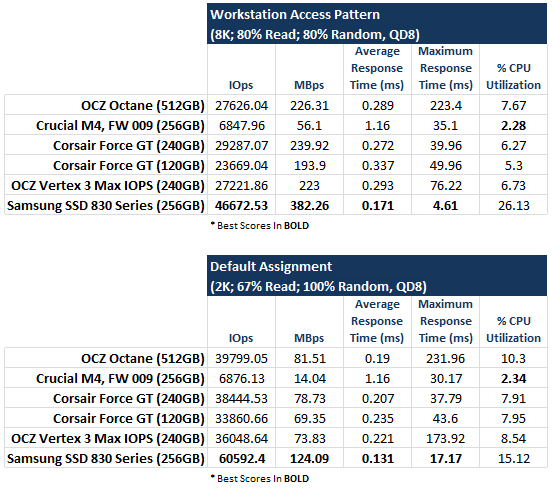OCZ Octane Series SATA III Solid State Drive Review
Our Test Methodologies: Under each test condition, the Solid State Drives tested here were installed as secondary volumes in our testbed, with a standard spinning hard disk for the OS and benchmark installations. Out testbed's motherboard was updated with the latest BIOS available as of press time and AHCI mode was enabled. The SSDs were secure erased and left blank without partitions wherever possible, unless a test required them to be partitioned and formatted, as was the case with our ATTO, PCMark 7, and CrystalDiskMark benchmark tests. Windows firewall, automatic updates and screen savers were all disabled before testing. In all test runs, we rebooted the system and waited several minutes for drive activity to settle before invoking a test.
|
Motherboard - Video Card - Memory - Audio - Hard Drives -
|
Hardware Used: Intel Core i7-2600K Asus P8Z6-V Pro (Z68 Chipset, AHCI Enabled) NVIDIA GeForce GTX 285 4GB Kingston DDR3-1600 Integrated on board WD Raptor 150GB (OS Drive) Samsung SSD 830 (256GB) OCZ Vertex 3 MaxIOPs (240GB) Corsair Force GT (240GB) Patriot Wildfire (120GB) Crucial M4 (256) OCZ Octane (512GB) |
OS - Chipset Drivers - DirectX - Video Drivers - |
Relevant Software: Windows 7 Ultimate SP1 x64 Intel 9.2.0.1030, iRST 10.5.1027 DirectX 11 NVIDIA GeForce 275.33 Benchmarks Used: IOMeter 1.1.0 RC HD Tune v4.61 ATTO v2.47 AS SSD CrystalDiskMark v3.01 x64 PCMark 7 SiSoftware Sandra 2011 |
|
As we've noted in previous SSD articles, though IOMeter is clearly a well-respected industry standard drive benchmark, we're not completely comfortable with it for testing SSDs. The fact of the matter is, though our actual results with IOMeter appear to scale properly, it is debatable whether or not certain access patterns, as they are presented to and measured on an SSD, actually provide a valid example of real-world performance for the average end user. That said, we do think IOMeter is a gauge for relative available throughput with a given storage solution. In addition there are certain higher-end workloads you can place on a drive with IOMeter, that you really can't with most other benchmark tools available currently.
In the following tables, we're showing two sets of access patterns; our Workstation pattern, with an 8K transfer size, 80% reads (20% writes) and 80% random (20% sequential) access and IOMeter's default access pattern of 2K transfers, 67% reads (34% writes) and 100% random access.

The OCZ Octane put up IOMeter scores that were competitive or somewhat better than SandForce-based offerings using our particular access patterns. The Samsung drive took the lead in most tests, but the OCZ Octane remained competitive in our workstation access pattern and even outpaced the remaining drives using IOMeter's default access pattern. The Octane's maximum response times, however, trailed all the others.
|
Next we ran SiSoft SANDRA, the the System ANalyzer, Diagnostic and Reporting Assistant. Here, we used the Physical Disk test suite and provided the results from our comparison SSDs. The benchmarks were run without formatting and read and write performance metrics are detailed below.

The new OCZ Octane performed well in the SiSoft SANDRA Physical Disk benchmark. Here, the drive offered competitive read speeds that were on par with other high-end SSDs and strong write speeds approaching the 400MB/s mark. The SandForce-based drives, however, held onto a big lead here in terms of write performance.






